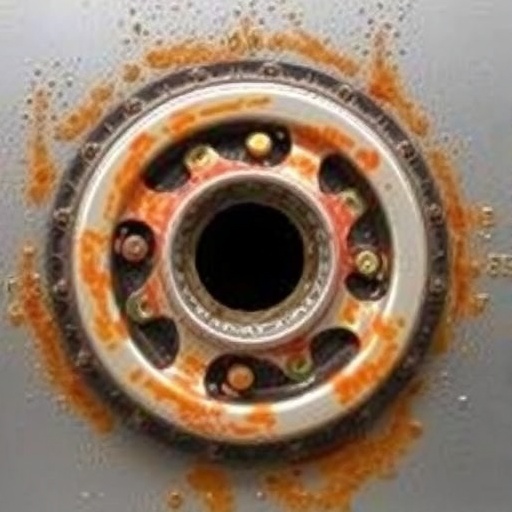Recent advancements in the field of materials science have increasingly focused on the properties and behaviors of metals, especially their corrosion resistance in various environments. Among various alloys, stainless steel has been a prominent subject of study due to its extensive applications across industries, where its durability and resistance to corrosion are critically valued. A notable area of investigation explores the impact of chloride ions (Cl⁻) on galvanic corrosion, a form of localized corrosion that can severely compromise the integrity of metal structures.
In a groundbreaking paper published in the journal Ionics, researchers Zhong, Deng, Cai, and colleagues elucidate the complex interplay between chloride ion concentration and galvanic corrosion processes in stainless steel. This research is particularly significant, considering the increasing prevalence of chlorides in coastal environments where infrastructure is widely deployed. The study utilizes sophisticated wire beam electrode (WBE) techniques to examine how varying concentrations of Cl⁻ ions influence corrosion dynamics.
The wire beam electrode technique represents a valuable advancement in electrochemical analysis. By enabling the assessment of localized corrosion reactions with high spatial resolution, WBE provides insights previously unattainable through traditional methods. The experimental setup involves a thin wire of stainless steel that serves as the working electrode, allowing researchers to detect micro-galvanic processes across a wide area with incredible precision.
One of the key findings of the research is the discernible increase in galvanic corrosion rates as chloride ion concentrations rise. Specifically, the study reveals that as the Cl⁻ concentration escalates, there is a concomitant acceleration in the electrochemical reactions responsible for localized corrosion damage. This relationship underscores the urgency of addressing chloride exposure, especially for critical infrastructure subjected to marine environments or de-icing chemicals.
In addition to quantifying the corrosion rates, the study delves into the mechanisms governing the galvanic corrosion process. The authors discuss how chloride ions contribute to the destabilization of the passive film that naturally forms on stainless steel surfaces, exposing the underlying metal to corrosive elements. This disruption may be exacerbated by factors such as temperature, pH, and the presence of moisture, all of which can intensify the susceptibility to corrosion.
Moreover, the researchers elucidate that the specific alloy composition of stainless steel plays a crucial role in determining its resistance to galvanic corrosion. Various grades of stainless steel exhibit differing responses to chloride exposure based on their chromium, nickel, and molybdenum content. This insight is vital for material selection in engineering applications, as it can guide the choice of stainless steel alloys for environments where corrosion risk is prevalent.
Another important observation from the study is the role of cathodic protection techniques in mitigating corrosion rates in high chloride environments. By employing sacrificial anodes or impressed current systems, it is feasible to enhance the corrosion resistance of stainless steel components significantly. This information is essential for engineers and maintenance personnel tasked with ensuring the longevity and safety of structures in aggressive environments.
The findings from this research are not only applicable to marine infrastructure but extend to various sectors, including automotive, aerospace, and energy industries. Any application that involves stainless steel components deployed in chloride-rich atmospheres can benefit from adapted material choices and coating strategies aimed at reducing corrosion risks.
Beyond practical applications, the study emphasizes the need for further research to deepen our understanding of the interplay between material properties and environmental factors. As industry demands evolve and environmental regulations become more stringent, it is crucial to prioritize novel strategies for enhancing corrosion resistance, particularly in light of climate change and its associated impacts on corrosion dynamics.
The implications of the study resonate throughout the scientific community, urging researchers to explore additional variables that could influence galvanic corrosion. For instance, further investigations may explore how varying temperatures or the introduction of biocides could affect corrosion behavior in chloride-laden environments.
The research marks a critical step in advancing our knowledge of corrosion science and highlights the importance of interdisciplinary collaboration among chemists, materials scientists, and engineering professionals. By understanding the mechanisms of galvanic corrosion, stakeholders can develop better practices for material selection, protective coatings, and maintenance protocols, thus ensuring safer and more reliable structures.
In conclusion, the investigation of chloride concentration effects on stainless steel galvanic corrosion, as revealed in this study, has significant ramifications for various industries. As we continue to explore the complexities of corrosion in an increasingly challenging environment, the insights garnered from this research will serve as a cornerstone for future innovations in material performance and corrosion mitigation strategies.
The future of corrosion science rests on the insights garnered from studies like the one conducted by Zhong and colleagues. It is a vivid reminder of how critical scientific inquiry can lead to actionable solutions that not only enhance material performance but also protect infrastructure and public safety in a world increasingly challenged by environmental factors.
This research offers a pivotal contribution to the ongoing effort to secure material integrity and longevity, providing a roadmap for industries that rely on stainless steel to combat the lurking threats posed by galvanic corrosion.
Subject of Research: The influence of Cl⁻ concentration on galvanic corrosion of stainless steel.
Article Title: Investigating the influence of Cl⁻ concentration on galvanic corrosion of stainless steel using wire beam electrode technique.
Article References: Zhong, H., Deng, C., Cai, H. et al. Investigating the influence of Cl⁻ concentration on galvanic corrosion of stainless steel using wire beam electrode technique. Ionics (2025). https://doi.org/10.1007/s11581-025-06739-7
Image Credits: AI Generated
DOI: https://doi.org/10.1007/s11581-025-06739-7
Keywords: Galvanic corrosion, chloride ions, stainless steel, wire beam electrode, corrosion resistance.
Tags: chloride concentration impact on metalschloride ion effects on metalscoastal infrastructure corrosioncorrosion dynamics in alloyscorrosion integrity of metal structureselectrochemical analysis advancementsgalvanic corrosion mechanismslocalized corrosion in stainless steelmaterials science researchstainless steel applications in industrystainless steel corrosion resistancewire beam electrode technique





